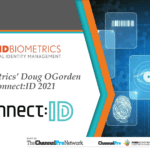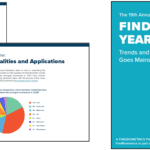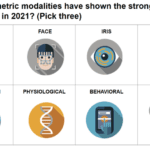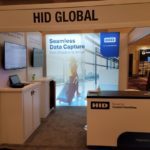 FindBiometrics President Peter O’Neill recently spoke with Crossmatch CEO Rich Agostinelli. The interview begins with talk of the autumn’s big news: in September Crossmatch was acquired by HID Global. After detailing how the acquisition will affect the company, Agostinelli shed some light on Crossmatch’s product line and use cases for its NOMAD biometric readers, as well as what’s new with the firm’s DigitalPersona business. DigitalPersona itself was the subject of an acquisition by Crossmatch in 2014, so it is appropriate that the conversation turns back to the current role of mergers and acquisitions in the biometrics and identity industries. Agostinelli is a long time industry veteran, so appropriately the interview concludes with what trends he sees as particularly exciting in today’s landscape of biometric innovation.
FindBiometrics President Peter O’Neill recently spoke with Crossmatch CEO Rich Agostinelli. The interview begins with talk of the autumn’s big news: in September Crossmatch was acquired by HID Global. After detailing how the acquisition will affect the company, Agostinelli shed some light on Crossmatch’s product line and use cases for its NOMAD biometric readers, as well as what’s new with the firm’s DigitalPersona business. DigitalPersona itself was the subject of an acquisition by Crossmatch in 2014, so it is appropriate that the conversation turns back to the current role of mergers and acquisitions in the biometrics and identity industries. Agostinelli is a long time industry veteran, so appropriately the interview concludes with what trends he sees as particularly exciting in today’s landscape of biometric innovation.
Read our full interview with Rich Agostinelli, CEO, Crossmatch:
Peter O’Neill, President, FindBiometrics: Let’s start off with the big acquisition news – HID Global acquires Crossmatch. Please tell us all about this.
Rich Agostinelli, CEO, Crossmatch: Sure, it’s a rather exciting time for our company, and I’m really pleased with the transaction. Francisco Partners have owned Crossmatch for several years, and they have been an excellent partner. But as I said in the press release, it’s a very different world today, Peter, than it was 18 years ago when I got into this business.
Back then, biometric systems, when implemented at all, were generally implemented in a very siloed way. It was a discreet criminal booking system or a discreet border control application, or a time and attendance application.
Today, as biometrics have expanded and the need for positive identity has grown, biometrics are at the core of commercial enterprise and ERP systems, and they’re at the core of government systems where databases are shared. As a result, the interaction between biometric and non-biometric methods of proving identity really need to interact, and our customers are starting to buy that way. They are buying complete systems that must be interoperable. Those systems have varying biometric and non-biometric endpoints, and so for us to be able to serve that market, we really needed to be in a different and larger class.
By becoming part of HID, which is a 3,000-employee multi-national company with a variety of products that are very complementary to ours, we think we’ll be able to address the needs of both our current and prospective customers in a much better way. Of course, this is great news not only for those customers but also our employees. The transaction offers expanded career opportunities and challenging work for them.
Biometrics, to me, is an important piece of the trusted identity technology industry, and by being part of HID we’re now a part of that industry in a significant way. So, we are all quite excited about the transaction.
Peter O’Neill, President, FindBiometrics: So, as one of the drivers, you mentioned the customers for both companies – what will this all actually mean for the combined customer bases?
Rich Agostinelli, CEO, Crossmatch: The way HID is organized is very similar to Crossmatch. They have a government ID business unit, a commercial ID business unit, and an identity and access management business unit. Of course, they have other operations, but these three business units align perfectly with the three Crossmatch business units – which have virtually the same names.
For example, we are able to take Crossmatch biometric components now and offer them alongside HID’s non-biometric identity management components in the government space. This enables us to address the full needs of the customer for a complete border control, civil ID or military application. We’ll have more arrows in the quiver that will be able to solve more of the customer’s needs. And that same paradigm follows through on the commercial side as well as the authentication side.
Peter O’Neill, President, FindBiometrics Can we talk a little bit about specific products that you have – one of them that I’m very interested in is on the mobile side of the equation. Mobile biometric identity systems continue to grow – please tell us about your NOMAD technology and some of the typical use cases that you see with that.
Rich Agostinelli, CEO, Crossmatch: We’re very excited about the NOMAD line – and thanks for bringing that up. We believe that it’s the thinnest and most compact technology available, which of course makes it perfect for mobile applications. It utilizes our capacitive TFT sensor, or thin-film transistor technology, but we have designed it into a variety of sizes and product offerings.
We have a FAP 30 – a single fingerprint reader that is PIV certified – which we designed into a single-handed use portfolio where it can be paired with virtually any mobile phone model that a police officer, for example, might carry. So the use case here is mobile ID. We gained immediate traction and issued a press release not long ago about a large scale deployment with the UK Met Police. They can easily carry this device with them for traffic stops or incidents on the street, where true identity is in question or unable to be ascertained. NOMAD easily integrates to enable positive identification in a very cost-effective way.
Not only is NOMAD lightweight, accurate and PIV certified, it is also quite inexpensive and operates with existing mobile phone assets already being carried. The single-handed use portfolio that accepts virtually any mobile phone form factor has gained attention, not only with the Met Police, but with other law enforcement departments elsewhere around the world.
We also have our FAP 60 Wireless Reader, which is a four-finger Appendix F certified device. We have gotten a lot of interest from border control agencies around the world because this is a device that you can just carry around in one hand and easily use to confirm identity. Whether handling exception processing at a busy crossing, processing a coach of holiday-makers in-situ or in more remote border patrol scenarios, being able to capture four-fingers while on the move in virtually any environment is so much easier than the traditional disembark, sort, queue, process – well, you get the picture.
There is also interest beyond the border for NOMAD, in the financial services market and other various commercial markets. This may also be driven by the other benefit of our capacitive TFT technology that makes it perform so well in mobile environments. Whether it’s one-finger or four-finger configuration, ambient light doesn’t affect the image capture because of the capacitive technology. Unlike optical technologies which don’t capture very well in bright sunlight, the capacitive TFT is impervious to the lighting conditions.
Mobility, as you mentioned, is a big driver. It has been and continues to be one of our strategic initiatives, and we think the NOMAD meets the needs our target markets very well.
Peter O’Neill, President, FindBiometrics Can you talk to me a little about the DigitalPersona side of your business and what’s new there?
Rich Agostinelli, CEO, Crossmatch: We are also very excited about that product line. It is an area that we have focused on in the last two years and enhanced the functionality of the product offering. This is what we refer to as our composite authentication solution – we call it composite authentication because we believe it offers more than your traditional multifactor application.
You might remember on our last call, I’d mentioned to you that TechRadar had ranked us as #1 in the Top 5 Best Identity Management Systems and Authentication Services for 2017. This year – in fact, just about a week ago – Software Reviews for Identity and Access Management, which is a report just published by Info-Tech, positioned Crossmatch and our DigitalPersona authentication software in the upper right leaders’ quadrant along with some very well-known names, such as Symantec and Microsoft. We also ranked as a Gold Medalist.
These were unsolicited reviews by publications that noticed us. So, we are very pleased that the market is recognizing our efforts – and of course, that is translating into additional business.
The other thing worth noting was our July release of DigitalPersona v3.0 introducing face recognition as an additional authentication factor. We also have contextual authentication for Windows Logon, which we are the only vendor to offer that capability, to our knowledge. And we also have a capability called IWA, or Integrated Windows Authentication, which enables the use of a Windows authentication factor as a token for subsequent log on to another application.
We are working hard to stay at the forefront in terms of our authentication offering. This has also been a key initiative for the business, and we are quite excited about the market’s acceptance.
Peter O’Neill, President, FindBiometrics Well that must be very rewarding to see that kind of recognition in the marketplace. I’d like to ask you a couple questions about the industry in general now. Do you expect to see more M&A activity in the biometric marketplace and why?
Rich Agostinelli, CEO, Crossmatch: Yes. Again, this is just my opinion, Peter. But following on what I said earlier, I think that more and more biometrics are just one enabling technology that is part of any effective security system or effective identity and access management system. It is challenging, I think, to operate with just one discreet biometric modality. What we are seeing is that customers are buying more complete solutions that require a variety of factors and I believe it is going to be more and more difficult for some of the smaller companies to continue to compete.
Traditional non-biometric ID management companies understand the power of biometrics, and want to add that in. And the traditional biometric companies are looking to address a broader market, and they need the non-biometric IAM companies to do that. It is a natural evolution of the market as we gain more widespread acceptance. So yes, I would see traditional security and IAM companies continuing to have an interest in pure-play biometric companies.
Peter O’Neill, President, FindBiometrics We’ve known each other for many years and have done quite a few interviews just like this one in the past. Now we’re seeing biometrics in so many new areas, as you just mentioned, from autonomous vehicles and robotics to healthcare, entertainment and retail – just about every vertical market is really starting to embrace biometrics. Looking forward, which areas of the marketplace excite you?
Rich Agostinelli, CEO, Crossmatch: Well, positive identification in online environments seems to be where it’s at – whether it is payments or other ways of just authenticating oneself online. Face-to-face authentication or person-to-person authentication or enrollment is just one segment. But the explosion is people doing things remotely from their personal device, whatever that device might be. The ability to prove identity in a non-face-to-face or an online world – the possibilities are endless as more and more business to business and consumer commerce is done remotely and from a mobile phone or personal endpoint.
And so, the ability to prove identity with a combination of biometric and non-biometric factors, continuous authentication in a variety of different ways, is what I see going forward. This is because positive identity is going to be so much more critical as the number of transactions that are done in a non-face-to-face way continues to proliferate.
Peter O’Neill, President, FindBiometrics: Richard, as always, it’s been a pleasure to spend some time with you today. I know you must be very, very busy with all the activities around the acquisition, so thanks again for carving out some time for us today.
Rich Agostinelli, CEO, Crossmatch: Always happy to speak with you, Peter. Thank you for making the time.








Follow Us